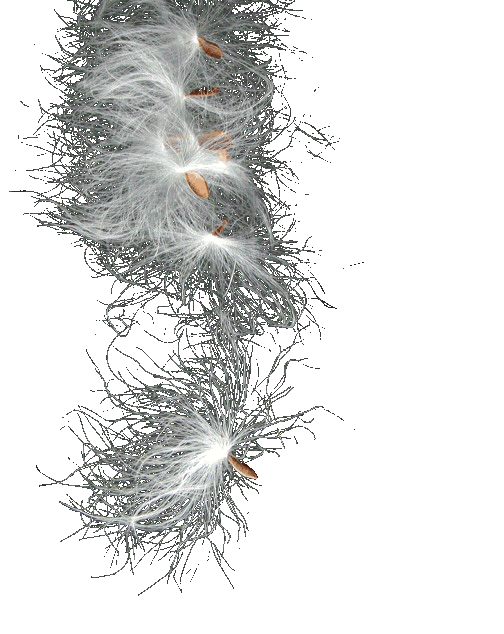The metal mark family
Lupine has a dusky, wine-like flavor when enough of it is concentrated in one place and the sun spends a few hours warming it over. It is a pungent smell that makes me want a purple lollipop- I can feel the grapeness it would leave on my teeth. The bluer hint of fermentation is just subtle and tangy enough to invite further exploration. It is seductive like my husband, when he's trying to be coy over our buckwheat pillows in the wintertime.
Buckwheat, in pillows, is the perfect neck support. In plant form it is the perfect metalkmark mating venue. The clustering white globes are lifted up by stemmy branches in a wheel-spoke pattern, and radiating from a woody trunk, they provide the nectar for adults. The broad, kelly-green leaves, regularly interspersed underneath the blossom branches like stairsteps, are often dotted with deposits of tiny lavender points: the perfect food for hungry multilegged infants.
When you think about the buckwheat plant, imagine them hovering, brown and orange, and now and then, a brilliant flash from the back of the wing--
Imagine, for instance, the Mormon metalmark:
perched in a hollow, waiting for a wife-metalmark, just like the real Mormon men at BYU who recently returned from their cocoon-like missions.
Years in the Mormon dating scene have made me an expert on Mormon men's mating behavior. Perching, for instance. Like the Mormon Metalmark, the men enjoy perching in prominent places so they can observe potential mates. They perch on chairs in college student centers, or on couches during church activities. Or perhaps a bold one might perch on a piano bench, fluttering fingers without metal marks.
The man, or the butterfly, will sometimes condescend to patrol, between certain hours of the day, for a female. The butterfly prefers the brightest noon hours: 11:00- 2:30, approximately. The men like early evening, after classes end. As curfew at Mormon universities is midnight, prowling is best completed by 11:00 pm at the latest.
When a Mormon Metalmark finds a mate, he settles down next to her, nudges her playfully, and they amicably partner up. Mormon men try this too, but their success rate is lower than that of the butterfly.
A Mormon can live in desert, forest or grassland. They are not endangered in the united states. But somehow, they are in Canada.
The Lange's metalmark,
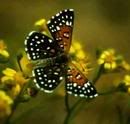
darker, dottier, and with wings as wedge-shaped as any good Mormon's, has a different courting pattern. He hangs around by the heady lupine flower with the intent of finding a female drunk enough to engage in wing-stroking.
Due to a lack of dunes resultant from over-enthusiastic brickmaking in the aftermath of the San Francisco earthquake in 1906, which also lead to the encroachment of non-native plants, the Lange's is one of the metalmark species known to be extremely limited in habitat. Lange's home currently totals a few acres along the San Joaquin river in the San Francisco Bay Delta. These few acres are now called Antioch Dunes National Park, which was organized in the early 1980's.
The little metalmark, a Floridian, is more common but still hard to find because his wingspan is only 5/8 of an inch. He is a tangerine-colored creature with adorable round wings that flash in the paler yellow color of their undersides. He has an attraction to a prickly yellow thistle and lives in cool, south-eastern pine forests.

Contrast him with the Fatal metalmark--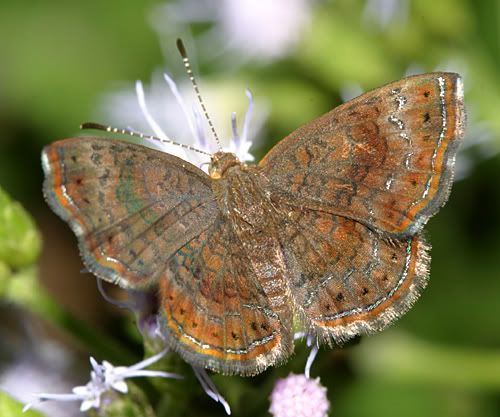
a dusky-winged, waterstained looking creature with unattractive progeny -- grey and dirty brown patterned caterpillars with yellowy beards and backhair. Fatal, apparently. But somehow prolific. This metalmark likes brushy neglected areas. Even polluted roadsides are acceptable, and the Seepwillow is the most useful food source.
The Seepwillow is common. It is considered ugly and worthless as forage, but apparently it is not completely useless...To the fatal at least. And to how many other easily unnoticed foragers? It is hard to say, because butterflies and other insects are often content with plants and places that humans generally find useless.
And it seems that when we do find a use for these useless places, the butterflies begin to disappear.
Lange is a good example of this. Yet Lange, isolated in a few duney acres, is mutliplying and replenishing again... But only because of further human interference. About the Lange project. I can't help but wonder: in our revamp to bring back an almost-lost species, how are we affecting the environment that has evolved in the meantime?
Is there, perhaps, some newly- acclimatized flea or scrubby oak that will not survive our continued manipulation of the environment? And how do we decide which species are more or important, or less worthy of saving?
I think about this a little too hard, and am suddenly afraid to weed my garden.
My next object of disucssion, the Lost Metalmark, is more subtly colored than the Lange, Mormon, or Small. She has dark brown wings with dusty metal pieces. She is beguiled by the snakeroot, like most south-western metalmarks. She is closest in geography to the many brilliantly colored Metalmarks of the Eden tropic in the southern continent, like this great blue-wing.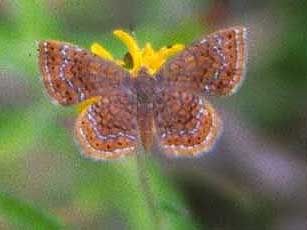
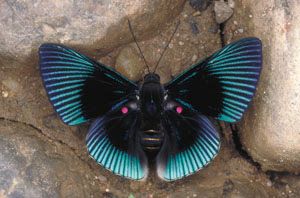
It is hard to believe that the two are related, yet the genus Riodinidae convinces us non-dissecters. The beautifully colored butterfly above is called Lyropteryx apollonia, or the Apollo Metalmark.
The variance of traits and behaviors within this Metalmark family is puzzling. I could, for instance, say more about the swamp metalmark, who is orangeish like a stale cheeto with silver moulding--the one your husband left in the couch. The Swamp is about as endangered as the Lange's.
Or I could go into greater depth about the Khaki-marked, cinnamon-hued Arizona metalmark. A potent male is 1 1/8", and has all the great state of Arizona (mountain habitat) to stretch out in.
Each in the Riodindae or Metal Mark family is similarly metaled, with the exception of the Mormon and a few others. Each seems only subtly different if you go from one degree of difference to the next, yet even an enthusiast could mistake two from the same scientific grouping, or species, for different animals rather than the genetic cousins that they are. Look again at Apollo there.
How can two with such unequivocally unique traits, looks, and preferences be a part of the same family?
Well, here are a few arguments for the classification: First, all male Metalmarks tend to have shorter forelegs. Second, Metalmarks often rest with wings part way open, and often on the underside of leaves. Third, Their eggs vary in shades of purple. And finally, from what experts have been able to catalogue, some (but only some) Metalmark caterpillars have a unique and symbiotic relationship with the ants in their native region.
These few random features and mannerisms seem, to me, a far-fetched way of classifying a group of family members.
So, then, is it really just the metal on the hindwings or fingers? Does the mark symbolize some kind of sacred genesis, a match made in heaven (or in dissection laboratories) that identifies two completely different animals and makes them, scientifically speaking, one?
I suppose such classification may not be that farfetched. Metal classifies my husband and I into a family, or coupleship at least, despite our obvious differences. My own metal mark is slimy because of too much oil and lotion, and has a few colored spots. His is a broad band that is unbreakable. Both are silver-colored. And they rest on the same lefthand fourth digit... His male, mine, female. If we were treated as butterflies, we would possibly satisfy all scientific conditions for classification as the same species. And in our case, such a grouping would not necessarily be innaccurate.
Above all when considering the Metalmark, one must realize that these insects are elusive; especially the North Americans. A few species are common, but we do not know much about the true variety of species, color and habitat among metalmark cousins.
I could say that this is mostly because many of the species look so similar in pattern, color and shape, and have common mating and food preferences.
However, I think the cataloguing difficulty is due more to the fact that many varieties are rare or endangered. And it is not unlikely, considering observed patterns of metalmark population and habitat preference, that a few varieties have already been rendered extinct.
We just didn't notice.
http://www.fws.gov/refuges/profiles/index.cfm?id=11646
http://www.fws.gov/sacramento/es/animal_spp_acct/langes_metalmark_butterfly.htm
http://www.nearctica.com/butter/plate12/Amormo.htm
http://www.fws.gov/sacramento/es/animal_spp_acct/langes_metalmark_butterfly.htm
Buckwheat, in pillows, is the perfect neck support. In plant form it is the perfect metalkmark mating venue. The clustering white globes are lifted up by stemmy branches in a wheel-spoke pattern, and radiating from a woody trunk, they provide the nectar for adults. The broad, kelly-green leaves, regularly interspersed underneath the blossom branches like stairsteps, are often dotted with deposits of tiny lavender points: the perfect food for hungry multilegged infants.
When you think about the buckwheat plant, imagine them hovering, brown and orange, and now and then, a brilliant flash from the back of the wing--
Imagine, for instance, the Mormon metalmark:

perched in a hollow, waiting for a wife-metalmark, just like the real Mormon men at BYU who recently returned from their cocoon-like missions.
Years in the Mormon dating scene have made me an expert on Mormon men's mating behavior. Perching, for instance. Like the Mormon Metalmark, the men enjoy perching in prominent places so they can observe potential mates. They perch on chairs in college student centers, or on couches during church activities. Or perhaps a bold one might perch on a piano bench, fluttering fingers without metal marks.
The man, or the butterfly, will sometimes condescend to patrol, between certain hours of the day, for a female. The butterfly prefers the brightest noon hours: 11:00- 2:30, approximately. The men like early evening, after classes end. As curfew at Mormon universities is midnight, prowling is best completed by 11:00 pm at the latest.
When a Mormon Metalmark finds a mate, he settles down next to her, nudges her playfully, and they amicably partner up. Mormon men try this too, but their success rate is lower than that of the butterfly.
A Mormon can live in desert, forest or grassland. They are not endangered in the united states. But somehow, they are in Canada.
The Lange's metalmark,

darker, dottier, and with wings as wedge-shaped as any good Mormon's, has a different courting pattern. He hangs around by the heady lupine flower with the intent of finding a female drunk enough to engage in wing-stroking.
Due to a lack of dunes resultant from over-enthusiastic brickmaking in the aftermath of the San Francisco earthquake in 1906, which also lead to the encroachment of non-native plants, the Lange's is one of the metalmark species known to be extremely limited in habitat. Lange's home currently totals a few acres along the San Joaquin river in the San Francisco Bay Delta. These few acres are now called Antioch Dunes National Park, which was organized in the early 1980's.
The little metalmark, a Floridian, is more common but still hard to find because his wingspan is only 5/8 of an inch. He is a tangerine-colored creature with adorable round wings that flash in the paler yellow color of their undersides. He has an attraction to a prickly yellow thistle and lives in cool, south-eastern pine forests.

Contrast him with the Fatal metalmark--

a dusky-winged, waterstained looking creature with unattractive progeny -- grey and dirty brown patterned caterpillars with yellowy beards and backhair. Fatal, apparently. But somehow prolific. This metalmark likes brushy neglected areas. Even polluted roadsides are acceptable, and the Seepwillow is the most useful food source.
The Seepwillow is common. It is considered ugly and worthless as forage, but apparently it is not completely useless...To the fatal at least. And to how many other easily unnoticed foragers? It is hard to say, because butterflies and other insects are often content with plants and places that humans generally find useless.
And it seems that when we do find a use for these useless places, the butterflies begin to disappear.
Lange is a good example of this. Yet Lange, isolated in a few duney acres, is mutliplying and replenishing again... But only because of further human interference. About the Lange project. I can't help but wonder: in our revamp to bring back an almost-lost species, how are we affecting the environment that has evolved in the meantime?
Is there, perhaps, some newly- acclimatized flea or scrubby oak that will not survive our continued manipulation of the environment? And how do we decide which species are more or important, or less worthy of saving?
I think about this a little too hard, and am suddenly afraid to weed my garden.
My next object of disucssion, the Lost Metalmark, is more subtly colored than the Lange, Mormon, or Small. She has dark brown wings with dusty metal pieces. She is beguiled by the snakeroot, like most south-western metalmarks. She is closest in geography to the many brilliantly colored Metalmarks of the Eden tropic in the southern continent, like this great blue-wing.


It is hard to believe that the two are related, yet the genus Riodinidae convinces us non-dissecters. The beautifully colored butterfly above is called Lyropteryx apollonia, or the Apollo Metalmark.
The variance of traits and behaviors within this Metalmark family is puzzling. I could, for instance, say more about the swamp metalmark, who is orangeish like a stale cheeto with silver moulding--the one your husband left in the couch. The Swamp is about as endangered as the Lange's.
Or I could go into greater depth about the Khaki-marked, cinnamon-hued Arizona metalmark. A potent male is 1 1/8", and has all the great state of Arizona (mountain habitat) to stretch out in.
Each in the Riodindae or Metal Mark family is similarly metaled, with the exception of the Mormon and a few others. Each seems only subtly different if you go from one degree of difference to the next, yet even an enthusiast could mistake two from the same scientific grouping, or species, for different animals rather than the genetic cousins that they are. Look again at Apollo there.
How can two with such unequivocally unique traits, looks, and preferences be a part of the same family?
Well, here are a few arguments for the classification: First, all male Metalmarks tend to have shorter forelegs. Second, Metalmarks often rest with wings part way open, and often on the underside of leaves. Third, Their eggs vary in shades of purple. And finally, from what experts have been able to catalogue, some (but only some) Metalmark caterpillars have a unique and symbiotic relationship with the ants in their native region.
These few random features and mannerisms seem, to me, a far-fetched way of classifying a group of family members.
So, then, is it really just the metal on the hindwings or fingers? Does the mark symbolize some kind of sacred genesis, a match made in heaven (or in dissection laboratories) that identifies two completely different animals and makes them, scientifically speaking, one?
I suppose such classification may not be that farfetched. Metal classifies my husband and I into a family, or coupleship at least, despite our obvious differences. My own metal mark is slimy because of too much oil and lotion, and has a few colored spots. His is a broad band that is unbreakable. Both are silver-colored. And they rest on the same lefthand fourth digit... His male, mine, female. If we were treated as butterflies, we would possibly satisfy all scientific conditions for classification as the same species. And in our case, such a grouping would not necessarily be innaccurate.
Above all when considering the Metalmark, one must realize that these insects are elusive; especially the North Americans. A few species are common, but we do not know much about the true variety of species, color and habitat among metalmark cousins.
I could say that this is mostly because many of the species look so similar in pattern, color and shape, and have common mating and food preferences.
However, I think the cataloguing difficulty is due more to the fact that many varieties are rare or endangered. And it is not unlikely, considering observed patterns of metalmark population and habitat preference, that a few varieties have already been rendered extinct.
We just didn't notice.
http://www.fws.gov/refuges/profiles/index.cfm?id=11646
http://www.fws.gov/sacramento/es/animal_spp_acct/langes_metalmark_butterfly.htm
http://www.nearctica.com/butter/plate12/Amormo.htm
http://www.fws.gov/sacramento/es/animal_spp_acct/langes_metalmark_butterfly.htm
